The Church of the Holy Archangels Michael and Gabriel in Nessebar
- Stefan Ivanov

- Mar 18
- 9 min read
Updated: 6 days ago
The Church of the Holy Archangels Michael and Gabriel is one of the most significant and impressive monuments of medieval architecture in the Old Town of Nessebar. It is an integral part of the architectural and historical reserve of the city, which was inscribed on the UNESCO World Heritage List in 1983.
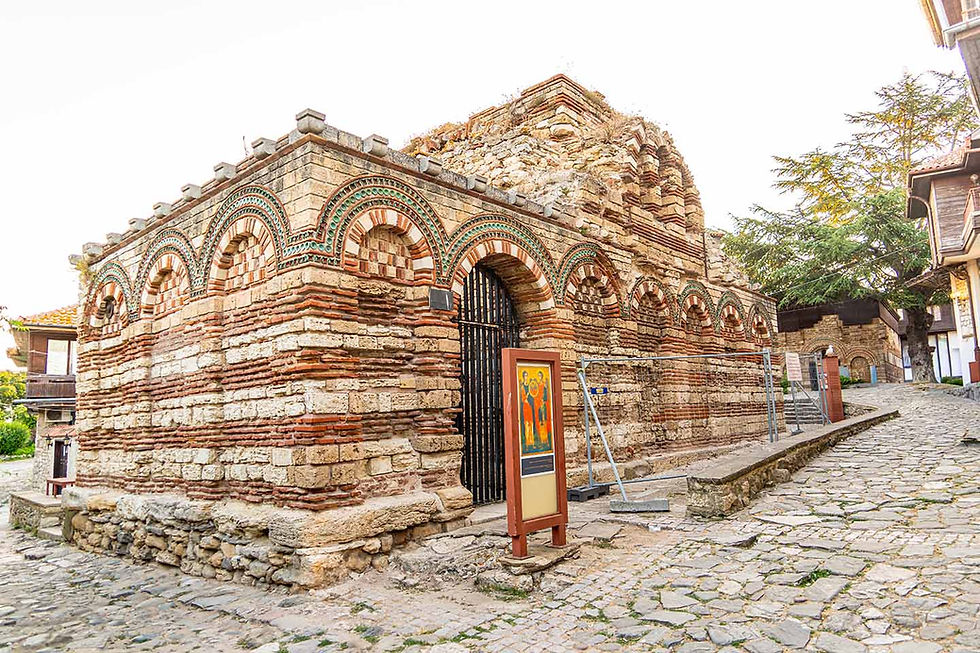
This recognition emphasizes its exceptional universal significance as a testimony to the rich history of the region and as a vivid example of church construction from the heyday of the Second Bulgarian Kingdom. Already in 1927, the temple was placed under state protection as a folk antique, and in 1964 it was declared a cultural monument of national importance.

The position of the church in the cultural landscape of Nessebar is crucial to its understanding. The city, founded 3,200 years ago as a Thracian settlement and known in Antiquity as Messembria, is one of the oldest in Europe.

During the Middle Ages, especially during the Second Bulgarian Kingdom (late 12th – 14th centuries), it established itself as an important commercial and spiritual center. The period was marked by a rapid development of church architecture, closely related to the ideology of the then social system. Legends claim that in medieval Nessebar there were over 40 churches, which speaks eloquently of its economic prosperity and deep spiritual life. The 23 of them that have survived to this day, as well as the many other archaeological finds, are evidence of its centuries-old existence. It is in this context that the church of "Holy Archangels Michael and Gabriel" should be considered, the study of which requires a detailed and critical approach.
Historical and Architectural Context
Based on its architectural features and similarities with other Nessebar churches, the Church of the Holy Archangels Michael and Gabriel has been dated to the 13th or 14th century. Some researchers, such as Jonathan Bousfield, associate its construction specifically with the reign of Tsar Ivan Alexander (1331–1371). During this period, Nessebar passed from Bulgarian to Roman hands several times, but this did not prevent the flourishing of church construction, which reflected both the state's greatness and the deep Christian faith of the population.
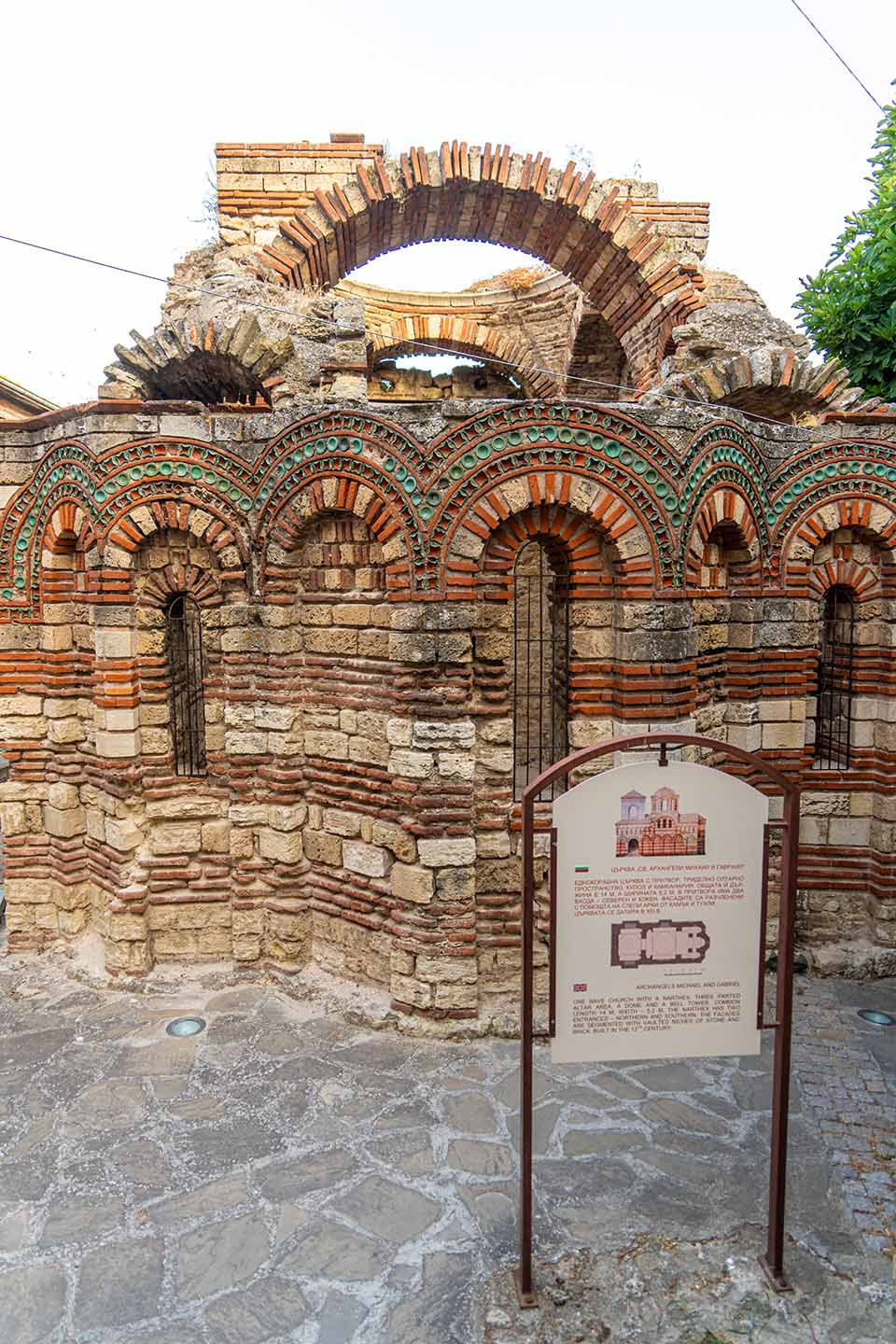
The Nessebar Church of the Holy Archangels Michael and Gabriel is a single-nave, cross-domed church with three apses.
Architectural plan and dimensions
The Church of the Holy Archangels Michael and Gabriel follows the traditional Byzantine plan of an inscribed cross, which is characteristic of the period. It is single-nave and in the past was topped with a wide dome, which is missing today. On the eastern side are three apses, each with a window, the central one being the largest and having three walls. Two columns, located at the junction of the side apses with the main one, divide the altar space into a prostheses and a diaconicon.
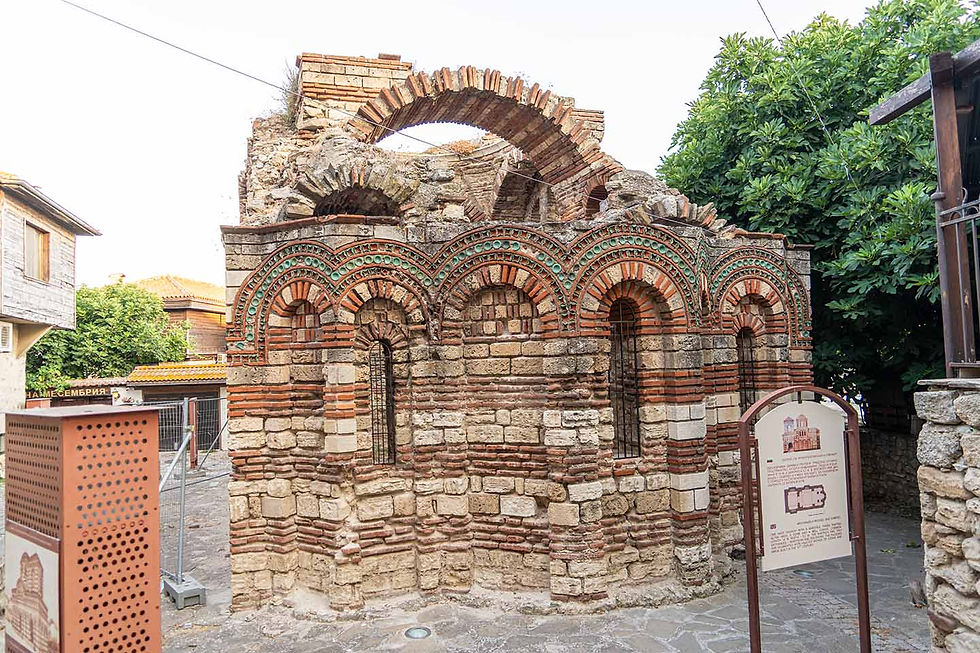
The dimensions of the temple, mentioned in different sources, vary slightly, but fit into the same range. They are given as 13.90 meters by 5.30 meters or 15 meters by 7 meters. The thickness of the walls varies from 0.85 meters to 1.30 meters. One of the distinctive architectural features is the large narthex, above which a square bell tower rose.

This is a characteristic element that is also found in other Nessebar churches of the same period, such as "Christ Pantocrator". Access to the tower is via a stone staircase located in the western part of the nave.
Construction and masonry technique
The construction of the church is carried out using the opus mixtum technique, which is widely used in Nessebar medieval architecture. This method involves skillfully alternating straight rows of brickwork with rows of hewn stones, arranged in a checkerboard pattern.

Typically, two rows of stone blocks are followed by three or four rows of bricks. This technique is much more than just a construction method; it is a fundamental component of the visual aesthetics of the temple. Through the play of colors and textures, opus mixtum contributes to the creation of the rich and multicolored exterior of the building, which is the basis of the so-called picturesque style.
Exterior decoration and the "picturesque style"
The exterior decoration of the church is its most remarkable element and is a typical example of the picturesque style that reached its apogee in Nessebar in the 13th - 14th centuries. The outer walls are decorated with a series of complex, interconnected blind arches - seven on the north and south walls and three on the west. Semicircular pediments are included in the upper part of the north and south facades, each with three windows.

The decoration is complemented by precise brickwork details and friezes made of triple bands with colored ceramic rosettes and circles located inside the arches. This style is marked by the skillful alternation of white stone blocks and red bricks, which together with the ceramic tiles form various patterns reminiscent of multi-colored embroidery.
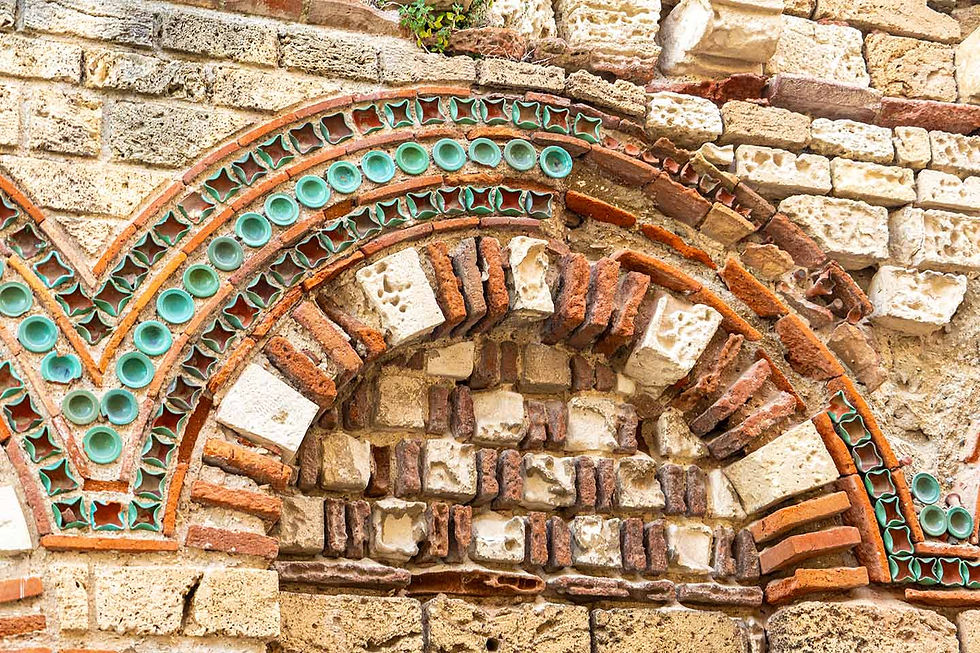
The external decoration is not accidental, but ideologically motivated, demonstrating the wealth and grandeur of the medieval Bulgarian kingdom, emphasizing the importance of church architecture in public life.
Interior space
The interior space of the church "Saints Archangels Michael and Gabriel" was divided by pilasters, which supported the dome through four arches. The temple could be entered through three entrances - one on the northern wall to the nave and two to the narthex.

Unlike other Nessebar churches such as "St. Stephen" or "St. Spas", the church of "St. Archangels Michael and Gabriel" has no preserved frescoes.
State of preservation and conservation
Today, the church of "St. Archangels Michael and Gabriel" is a partially preserved ruin. Most of its roof is missing, and the surviving arches are reinforced with steel braces to stabilize the structure.

The site is at the center of modern conservation efforts. In line with the latest UNESCO trends, the Municipality of Nessebar has initiated a conservation and restoration project, including an innovative protective coating of ETFE membrane. This project applies the so-called values approach, based on a comprehensive assessment of economic, cultural and social impacts. The process involves the use of modern technologies such as 3D laser scanning and aims to preserve the most authentic appearance of the ruin, rather than striving for a complete reconstruction. This approach is in line with other important conservation activities in the city, such as the US government-funded project for the Church of St. John Aliturgetos, which demonstrates the city's commitment to international cooperation in the field of cultural heritage conservation.
Analogies with the Church of Christ Pantocrator
The Church of the Holy Archangels Michael and Gabriel shares many architectural and stylistic similarities with the Church of Christ Pantocrator, dating to the same period (13th – 14th centuries).

Both churches are remarkable examples of the picturesque style and have common features in their plan and decoration. One of the most striking similarities is the presence of a square bell tower that rose above the narthex, which was reached by an internal staircase. This architectural feature demonstrates unity in the building traditions of Nessebar and suggests that the churches are the work of the same local architectural school or were built under similar influence.
Place in the context of the Nessebar picturesque style
The Church of the Holy Archangels Michael and Gabriel is not an isolated monument, but is part of a comprehensive architectural school that determined the appearance of Nessebar during the Middle Ages. It belongs to the group of remarkable churches that demonstrate the flowering of the picturesque style, together with Christ Pantocrator and John Aliturgetos.
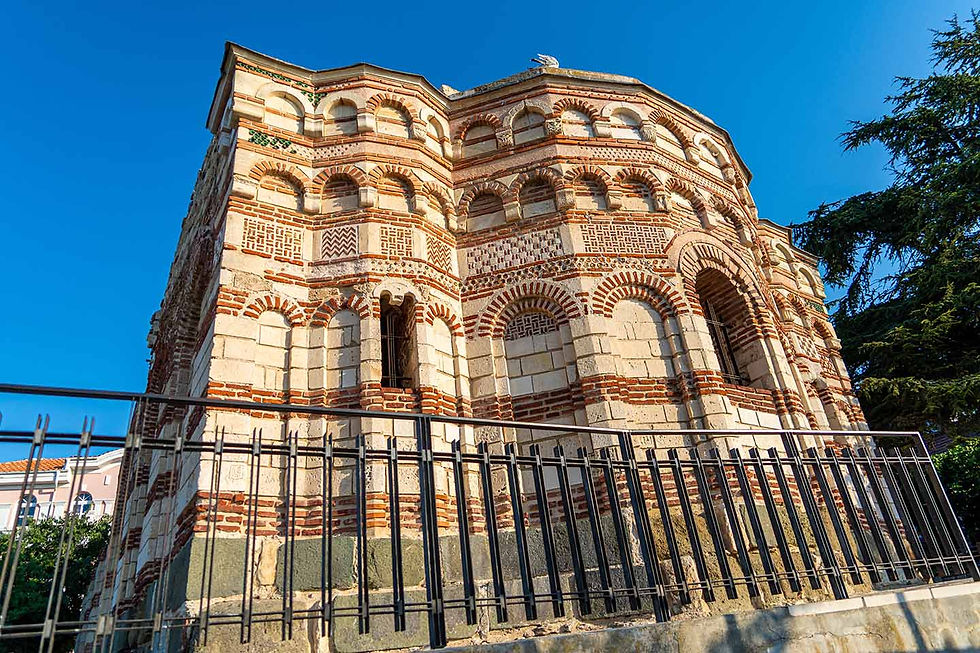
Common characteristics of this style include the use of the opus mixtum technique, the rich and intricate exterior decoration with arches, niches and ceramic elements that transform the facades into works of art.
Main architectural features of the church "St. Archangels Michael and Gabriel":
Dating – 13th – 14th century
Architectural plan – Byzantine inscribed cross, single-nave, cross-domed
Dimensions – 13.90 meters x 5.30 meters
Wall thickness – 0.85 meters to 1.30 meters
Masonry technique – opus mixtum (alternating stone blocks and bricks)
Key elements – narthex with a bell tower, three apses, blind arches, ceramic decorations
Current condition – partially preserved ruin, missing roof, reinforced arches
Status
Since the site is a ruin, the visit is focused entirely on examining its remarkable external architecture. Visitors express admiration for its strange style and interesting design, as well as the well-kept gardens around it.

It is recommended to combine the visit with a visit to other historical sites nearby.
The Church of the Holy Archangels Michael and Gabriel in Old Nessebar is an architectural masterpiece of the 13th-14th centuries and one of the most striking examples of the picturesque style that reached its apogee in the city. It is a valuable testimony to the flourishing of church construction during the Second Bulgarian Kingdom and is a key component of the cultural heritage of Nessebar, recognized by UNESCO.
Although today the temple is a partially preserved ruin, it is the subject of serious and innovative conservation efforts that demonstrate the modern approach to the preservation of cultural heritage. These efforts include the application of modern technologies and methods aimed at preserving the authenticity of the site.
Finally, a thorough study of the available information shows the importance of critical assessment. Distinguishing facts from inaccurate and contradictory data related to other churches with the same name or to false statements about its condition is essential for the correct understanding and perception of this exceptional cultural monument.
In 1927, the church "Holy Archangels Michael and Gabriel" was declared a national antiquity.
In 1964, the church "Holy Archangels Michael and Gabriel" was declared an architectural and construction monument of culture with the category of national importance.
Nessebar - a journey through time, embraced by the sea and whispering stories
Sometimes we need to stop for a moment, leave the hectic everyday life behind us and immerse ourselves in an atmosphere where time has stopped.

Ancient Nessebar is just such a place.

Situated on a small, rocky peninsula, connected to the mainland by a narrow strip of land, this city is like a treasure trove, protected by the waves of the Black Sea.

Nessebar is located:
412 kilometers (about 3 hours and 59 minutes by car) from the capital
277 kilometers (about 2 hours and 55 minutes by car) from the city of Plovdiv
100 kilometers (about 1 hour and 48 minutes by car) from the city of Varna
35 kilometers (about 36 minutes by car) from the city of Burgas
The ancient town of Nessebar is a living museum. Here, antiquity, every ruin, every paved street and every ancient house carry the spirit of bygone eras.

As soon as you pass the old mill, you will be greeted by a labyrinth of cobblestone streets that wind between old houses with characteristic wooden facades and flower gardens.

The air is filled with the scent of the sea and history.

Don't miss the over 40 churches that whisper stories of the greatness of Byzantium, and feel how history intertwines with the sea. Some of them are ruins, others are perfectly preserved, but all of them are witnesses to the greatness of the Byzantine Empire and the Middle Ages.

But Nessebar is not just a museum. It is a living city that breathes in unison with the sea. Allow yourself to get lost in the narrow streets, browse the small shops with handmade souvenirs and sit in a cozy restaurant with a view of the sea.

In the evening, when the sun sinks into the sea waters and the city lights reflect on the calm surface, Nessebar becomes a magical place that will leave a lasting impression in your heart.

Come and feel the magic of time in Ancient Nessebar!

Surrender to the charm of the wooden houses perched above the cliffs and let the wind tell you about the ancient seafarers.

In the evening, when the sun reflects in the sea, Nessebar turns into a magical place.

Visit Old Nessebar and touch eternity - here time simply stops.
How to get to the Church of the Holy Archangels Michael and Gabriel?
The Church of the Holy Archangels Michael and Gabriel is located in the central part of the Old Town of Nessebar.
I advise you to leave your car in the large northern municipal parking lot (a parking fee is required). You climb some of the many steps leading to "Kraibrezhna" street and along one of the many narrow cobblestone streets you head to the central part of the Old Town of Nessebar.
The church is not an active or museum site, with no opening hours or entrance fees.
You are reading an ad-free blog – fully focused on the content!
I remind you that you can read all my posts here – in "Photo Moments", without being interrupted by a single annoying ad, because "Photo Moments" is a place without ads!
I made the important decision to make "Photo Moments" ad-free so that my site can load much faster, the content I present to you can be as clean as possible, and your experience in "Photo Moments" can be the best possible!
If you appreciate everything I do, you can support me HERE or by following the gold star below.
Thank you!
And finally, my dear friends,
you shouldn't miss checking out
the special photo album with moments –
discovered, experienced, filmed and shared with you!

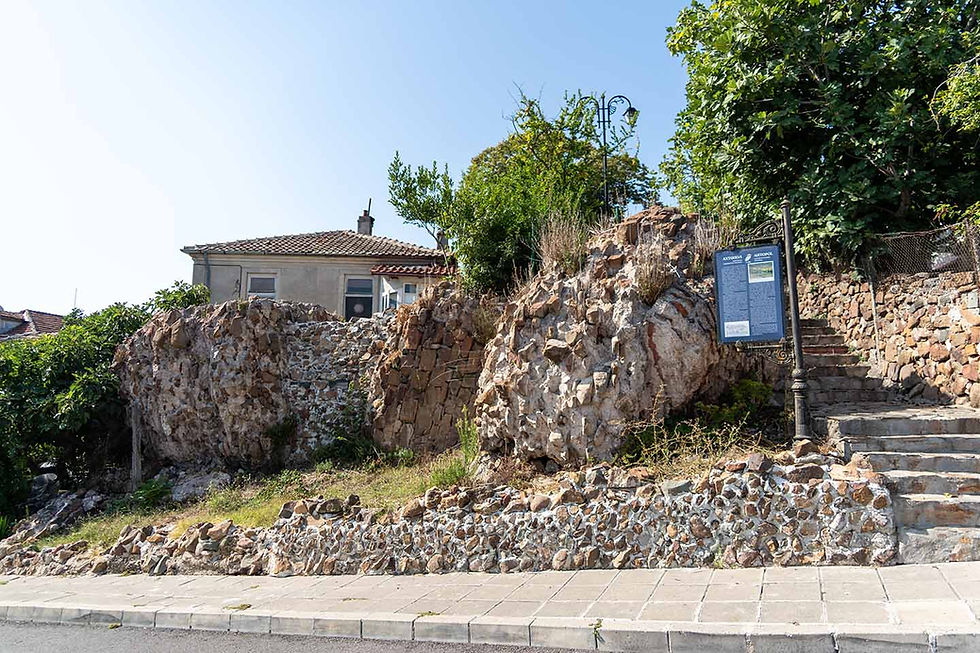


コメント